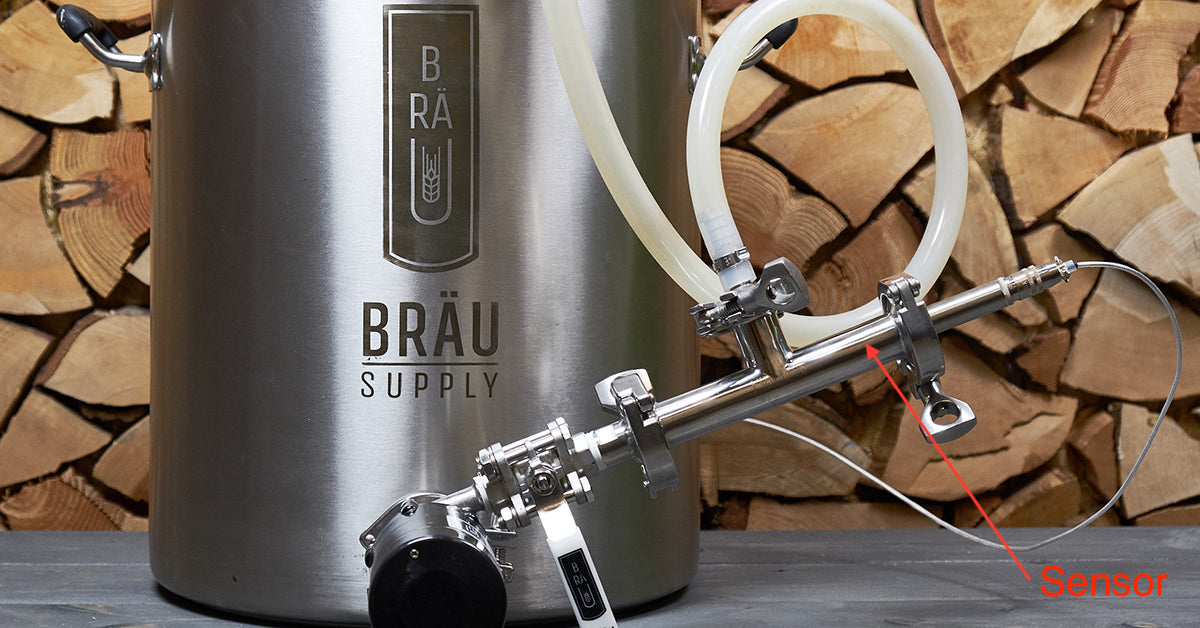Boxing weekend sale! Save up to $700! Shop now Our products ship tariff free

Where To Measure The Temperature In The Mash
May 10, 2019 4 min read

This question comes up a lot with our customers, and getting an accurate reading can be a challenge for beginning brewers. If you are like me, you're reading the temperature from a handheld device, and then measuring the temperature coming out from under the mash tun plate, or in our case the grain basket in one of our all-in-one brewing systems, and they can be different. So which one is correct?
I realized after learning to brew, that if one knew something in the field of thermodynamics, they had a head start. I'm not an engineer, but through a lot of research and trial and error, I believe I can contribute to the subject. At Bräu HQ I happen to have a lot of probes, and when designing a new system, I can never have enough. One on the mash input, a few in the grain bed, one under the mash tun, and one on the outlet valve. If I'm using a 3 vessel system, I'll add a few to the HLT as well. One on the HERMS output, and one in the body. Even if I've calibrated all the probes, not one reads the same, or exactly the same. But having all these probes has helped me to understand what is happening in one of our electric brew systems. Not all of us have the means for so many temperature sensors and if you've got only one for an all-in-one system, or a few in a Herms, where should they go?
In this post, I want to talk about sensor placement in the Unibräu all-in-one electric brew system which is similar to a BIAB (brew in a bag) setup.
In a continuous recirculating system such as the Unibräu, the wort is pulled from under the grain basket, through the pump, and back to the top of the grain bed. The wort then travels through the grains, and is heated again from the bottom underneath the grain basket, before being pumped back up over the grains.
Common wisdom is to measure the temperature of the mash at the midpoint of the kettle, so you get a good approximation, but I disagree. What happens when you measure with grains in the kettle, is very different than measuring with just water. The grains create hot/cold spots locally, as there are pockets where there’s not a lot of liquid movement. You could stir the grains constantly and get a better reading, but you risk the ‘setup’ or filtration ability of your grain bed, and the clarity of the wort. The solution to this problem is to ignore the probe in your kettle (for the most part) and measure the liquid that is travelling through the grain bed.
Some say to measure the liquid at the top, as it’s entering the grain bed, and some say to measure it from the bottom, as you are pulling the liquid out of the kettle.
With the Unibräu, you won’t notice much of a temperature difference if you place the probe in a tee at the top as it enters, or leave it in the kettle. When you add the element upgrade kit, you don’t have a choice, you need to remove the probe from the bottom of the kettle, and I’ll cover the correct placement a little further on. However, as the grain bill get’s denser (ie: you are adding a sparge step to brew that kick ass NEIPA, and you need all the kettle space you can get), you may notice a temperature variation of the wort entering the grain bed, vs. The temperature of the wort underneath the grain basket. At this point you need to pay attention as to where you are measuring the mash temperature.
So, where do I prefer and why?
Well, I designed the Unibräu with the sensor at the bottom of the kettle, because this will give me the most accurate temperature of the mash. When heating the mash, the temperature you are reading is how hot the grains have actually risen to, as there can be temperature losses as the liquid travels through the tubing, and enters back to the top of the grain bed. With the Unibräu, this isn’t a big system, so it’s insignificant, but let’s say you are brewing on a much larger system, or even a HERMS setup, you most definitely will have variations of temperature. The wort being pumped over the grain bed can be at desired mash temperature, however the grains may be a few degrees behind. This is why measuring the wort from under the mash tun is the only reliable indicator that your grains have indeed risen to your desired mash temperature.
So let’s add in the element upgrade kit. Where and how should you install it for success?

Above is the correct sensor placement for the Unibräu, if placement under the mash tun plate is not an option.
I recommend to place the tee right after the pump, you won't have any temperature losses this close to the mash, and removing the probe from the kettle gives you the option of measuring the chilled wort temperature. When you connect the plate chiller after the boil, you can simply move the tee to the outlet of the plate chiller, and you can now ensure that you have correct pitching temperature, throttling the ball valve and using the sensor to measure the outflow of wort until you are satisfied.
I hope this clears up some questions you may have about temperature placement. Feel free to comment below, and share with us your experiences!
MORE ARTICLES ON BREWING
https://brausupply.com/blogs/news/the-comprehensive-guide-to-mash-ph-in-all-grain-brewing
https://brausupply.com/blogs/news/what-causes-a-fermenter-to-heat-up
https://brausupply.com/blogs/news/a-beginners-guide-to-electric-brewing
https://brausupply.com/blogs/news/mastering-the-cold-side-of-brewing-a-comprehensive-guide
Subscribe
Sign up to get the latest on sales, new releases and more …

